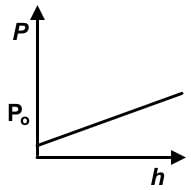Test: Fluids at Rest - MCAT MCQ
10 Questions MCQ Test - Test: Fluids at Rest
On which of the following does the buoyant force on an object floating on the surface of a liquid most directly depend?
There is a 1-liter container filled with 500 milliliters of water placed on top of a scale displaying 80 pounds. When a metal cube is submerged tied to a string end into the container, which of the following statements accurately describes the result?
A gold crown recently acquired is suspected to be brass covered in gold. The crown weighs 25.0 N in air and has an apparent weight of 22.5 N in fresh water. Based on these results, which of the following conclusions is correct?
(ρgold = 19,300 kg/m3, ρbrass = 8300-8700 kg/m3)
(ρgold = 19,300 kg/m3, ρbrass = 8300-8700 kg/m3)
When the gauge pressure is doubled, what happens to the absolute pressure?
A patient is scheduled to receive an intravenous injection of medication that must be at least 109.3 kilopascals at the injection point before going into surgery. If the patient is lying on a bed 0.9 meters high, what is the minimum height above the ground that the nurse must suspend the bag to achieve that pressure at the injection point?
(ρfluid = 1020 kg/m3)
Which of the following graphs represents the hydrostatic pressure for an incompressible fluid in a container open to the atmosphere on the surface of the Moon? (P0 = atmospheric pressure on Earth’s surface, h = height above Moon’s surface)
Which of the following scenarios most accurately represents Pascal’s law?
A 30 kilogram object is dropped into acetic acid, which has a specific gravity of 1.06. Once it is immersed in acetic acid, the object has an apparent weight of 240 N. What is the object’s specific gravity?
Which of the following statements about fluids at rest is true?
What property of a fluid allows it to exert pressure equally in all directions?
















